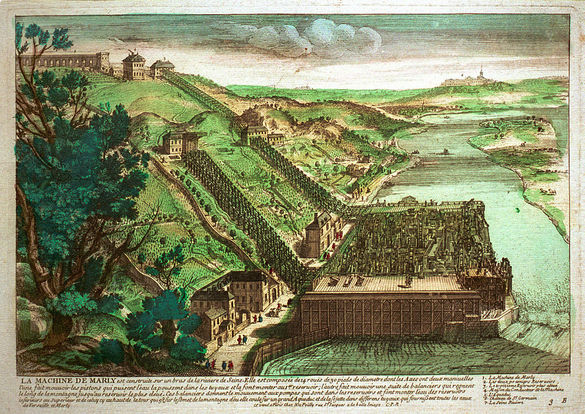The gardens are one of the most famous features of Versailles.
It's estimated that about 30% of the cost of the palace went into the gardens.
Of the original 8,000 hectares, only 10% of the gardens remain today.
The gardens originally featured over 1,000 fountains.
This posed a significant engineering challenge.
Indeed Versailles consumed more water than Paris itself - guzzling more than 12,000 cubic meters a day - and draining all the ponds in the area.
To address this, a massive machine, the Machine of Marly, was constructed, to pump water directly from the Seine and bring it to the palace via an aqueduct.
The Machine took 3 years to build.
It was equipped with 250 pumps, massive 11m wheels and a staff of 60... but it still wasn't enough.
So gardeners resorted to a much simpler method : they would whistle to each other when the king approached - so they could switch on and off the fountains!
Like many artworks in Versailles, the fountains were designed to underscore Louis XIV's absolute power.
The Fountain of Latona depicts the myth where Apollo, his sister and his mother were thrown rocks by local peasants before being turned into frogs by Zeus.
The Fountain of Apollo shows the god Apollo soaring into the sky in his chariot.
You also cannot miss the Grand Canal.
Measuring a massive 60m wide and 1.5km long, it would have been full of boats - including a caravel, a galley and a frigate.
Louis XIV even had barracks constructed near the canal to accommodate the sailors.
He also created 15 intimate gardens, enclosed by hedges : the bosquets.
These functioned like small salons, where people could meet to chat and organise parties.
One bosquet featured a labyrinth with 300 statues illustrating Aesop's fables.
It was said to have helped teach the young Louis XV how to read.
Another bosquet became the backdrop for an infamous scandal involving Marie-Antoinette.
Louis XV had ordered a $14 million necklace for one of his mistresses.
Unfortunately he died before paying for it.
Hearing of this, a woman at Versailles arranged a meeting between a wealthy cardinal and a woman pretending to be Marie-Antoinette.
After the meeting, the cardinal became convinced that Marie-Antoinette was madly in love with him and wanted him to buy her the necklace - which he did!
Louis XIV also organised a famous party in the gardens to celebrate the start of Versailles' construction.
It was a week's worth of festivities, including music, plays, dances, and lavish banquets...
Thousands of nobles attended, but the limited number of rooms at the palace meant many had to sleep in their carriages!
















.jpeg)